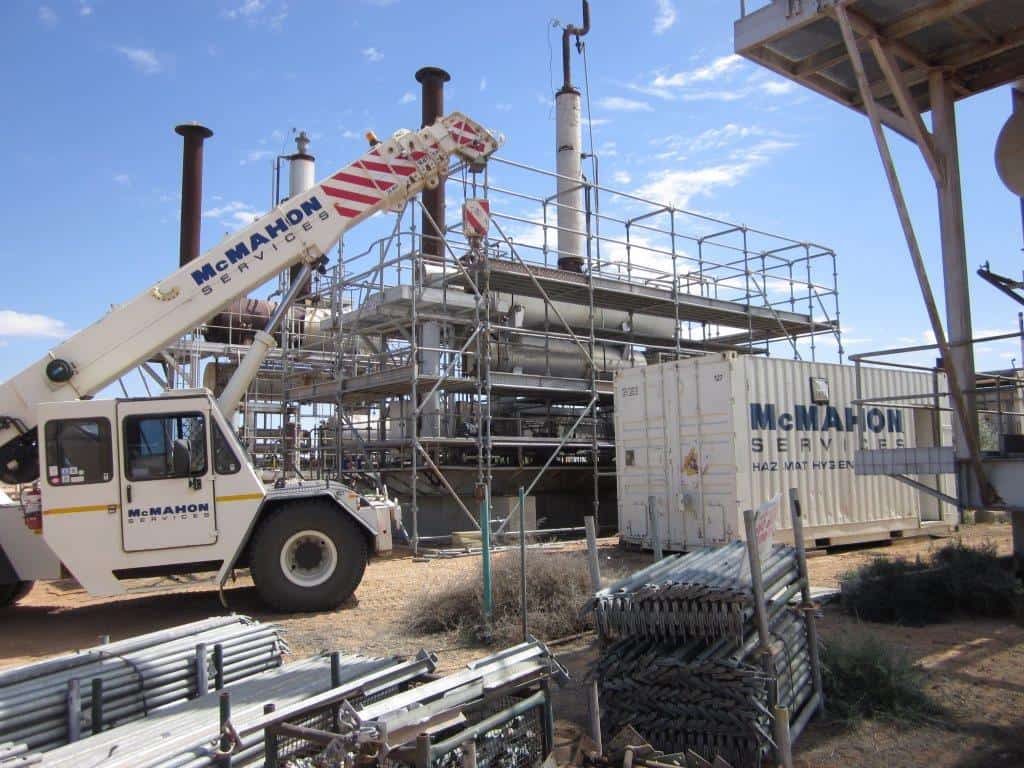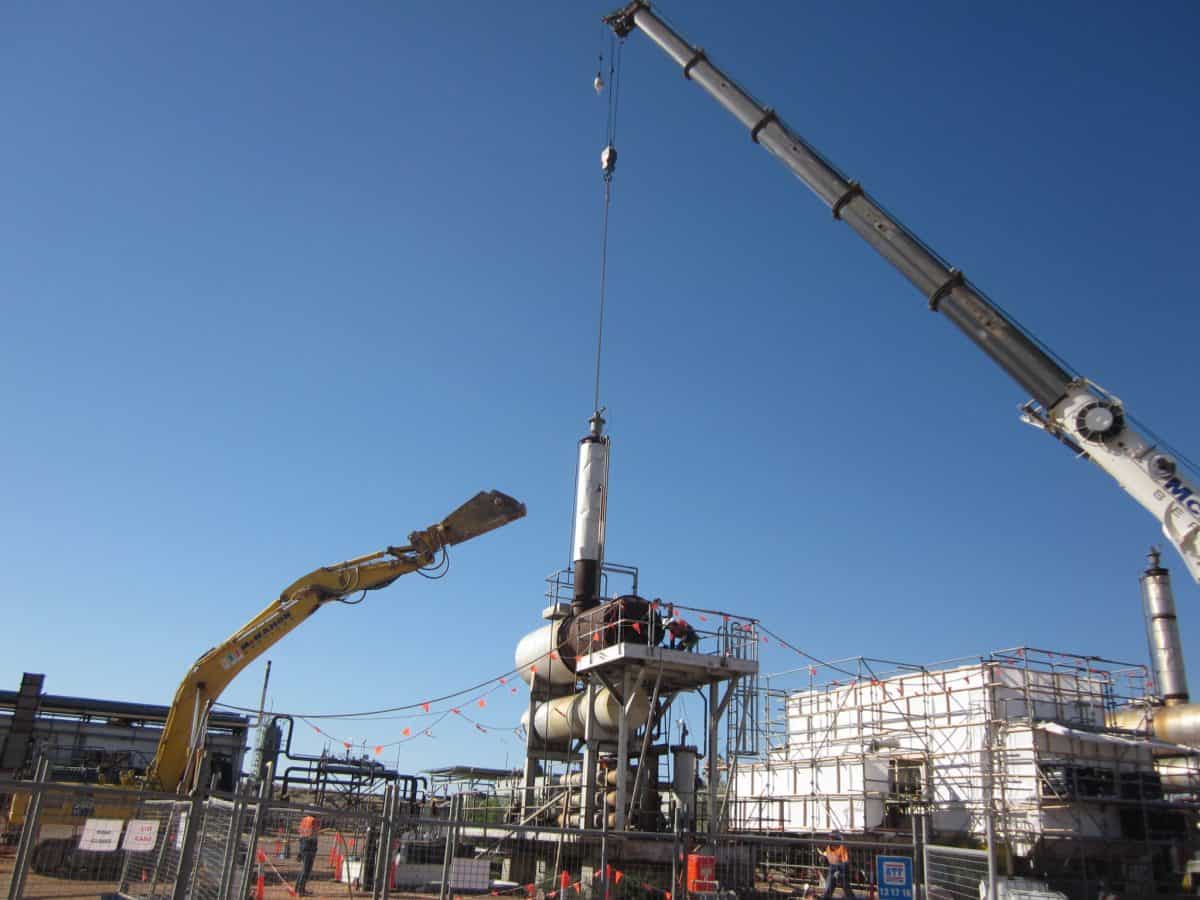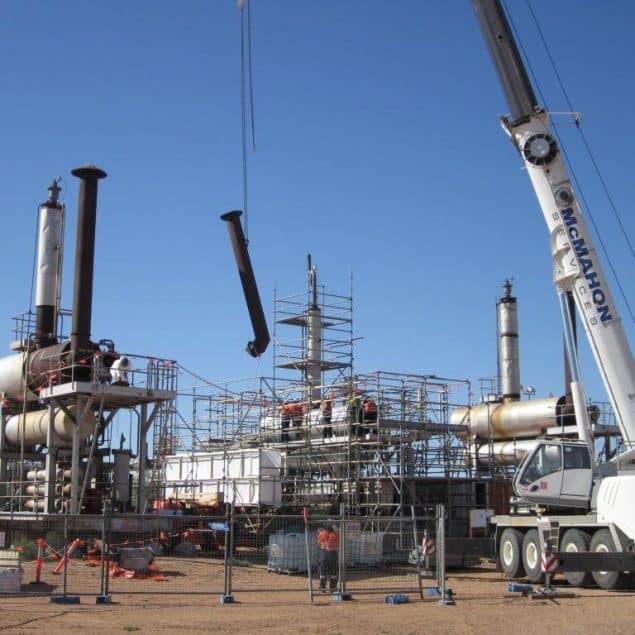McMahon Services was engaged by Santos to carry out the removal of three redundant TEG units at the Big Lake satellite Gas Processing Plant, a key infrastructure facility at Moomba.
Located 40km from Moomba in the Cooper Basin in the North East corner of South Australia, the project posed significant challenges, particularly the remoteness of the location and the extreme climatic conditions encountered.
Works commenced in September and ran through till early March, the hottest part of the year. Daytime temperatures regularly exceeded 45 degrees and reached a maximum of 49.6 degrees. The heat was accompanied by strong winds which regularly saw dust storms and localised areas of raised dust, impacting the works. This project was the first physical onsite activity initiated by Santos under their Cooper Basin Infrastructure Expansion Program (CIEP).
Conducted within the boundaries of the live gas processing facility, stringent workplace permitting and procedures were implemented to ensure that Santos operations were not impacted. This required constant liaison with operations personnel.
The scope of work was to remove the TEG Units to the top of the pedestal footing, which included a destructive hazmat survey; removal of friable asbestos insulation and asbestos gaskets; and deconstruction of the units themselves.
This was conducted using cold cutting techniques and heavy cranage, utilising McMahon Services 250t Tadano crane. Approximately 6,000 litres of glycol and other organic liquids were also removed from the TEG Units and disposed of carefully offsite. The friable asbestos removal had to be carried out under a full negative air environment.
This required the construction of a full scaffold enclosure with internal working decks to provide access. The framework was fully encapsulated with 200cm plastic, and three-phase extraction fans fitted with HEPA filters were installed to create the negative air environment.
The extreme temperatures within the working enclosure required strategies to be put in place to ensure the work crew were not adversely affected. These included:
- High focus on fluid intake and rehydration during breaks;
- Shortened work periods and increased break frequency;
- Air conditioned recovery rooms;
- Chilled air to full face masks;
- Increased air changes within the asbestos removal zone;
- Water chilled vests for personnel in work area.
- These measures saw the successful removal of 48,200 litres drums of bagged friable asbestos, which was transferred off-site for disposal.
The TEG Units were successfully dismantled, with asset lifts of up to 20t, and craned to grade where they were processed using a high volume scrap shear mounted on a 30t excavator. The original concept was to transfer the resultant scrap to the Moomba receivable yard, but McMahon Services provided added value to the client by transferring the scrap off-site for sale and disposal.
Upon successful completion of the contracted scope, McMahon Services was requested to develop a safe procedure for the removal of the TEG Unit footings. The footings were substantial weighing some 25t, and no percussive hydraulic breaking was allowed to be performed.
A system of hydro excavations to expose the footings; cutting the concrete footings using a wire saw and wall saw; rigging and craning the segments away, was successfully implemented. A key component of this work was: hydro excavation to identify in-ground services; scanning of in-ground services; and the development of category A and B excavation permits for approval.
As the project progressed, Santos engaged the McMahon Services team to complete several additional tasks. The extra work included mechanical and hydro excavations at the site, placement of services, the construction and installation of a telecommunications tower, crane and rigging works, and providing services to other subcontractors to support their excavations, demolition, planning and permits.
The footing removal process identified significant volumes of unsuitable subgrade material. As the area was to be prepared for the installation of the new compressor units, suitable compaction levels were critical. McMahon Services carried out the removal and re-installation of some 2,250 cubic metres of fill.
The project was an outstanding success, highlighting McMahon Services self-delivery model. There were no LTT, FA or MTI incidents and the project was delivered within budget.




